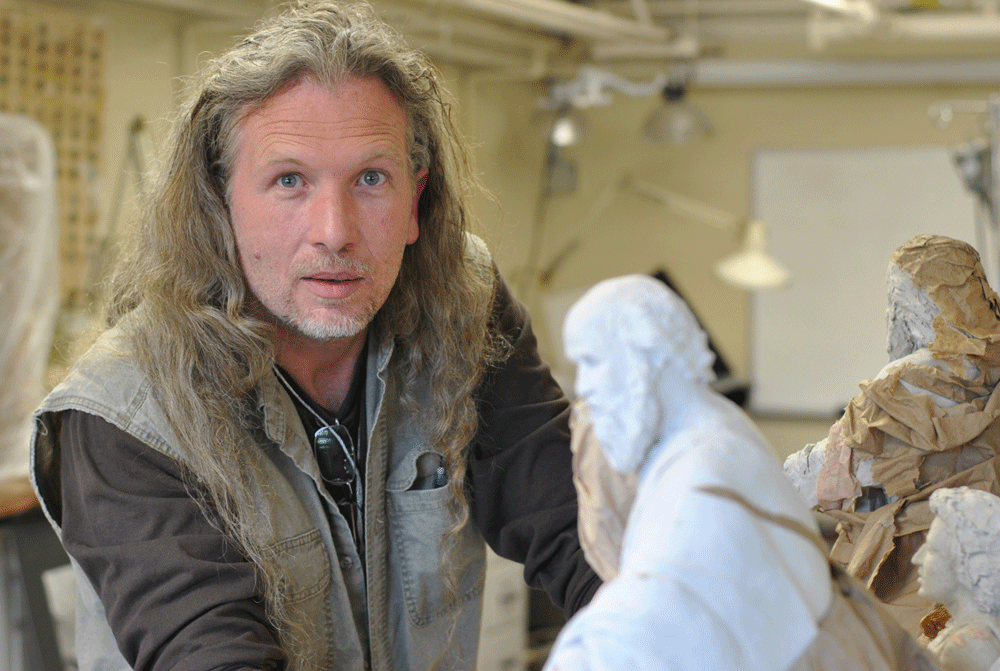Long, worn curls of salt-and-pepper hair suggest that Matt Mabis is a free spirit who has collected a rich history of story and adventure. The wrinkles on his face, set aglow by the twinkle in his eye, leave no doubt that he walks the earth sharing kindness and nurturing the lives of those he meets. He is a man who rides the wave and lets the current of life push him in new directions. Nudged by fate, Mabis ended up working as an instructor on the teaching staff at the University of Saint Francis School of Creative Arts. Interestingly, he attends the same school as a full-time student working to earn his Bachelors of Fine Art in sculpture.
The path that Mabis followed to this point could be compared to that of an Escher labyrinth, with zigs and zags that lead to dead ends and suddenly flip course, escorting Mabis to interesting opportunity.
Like most artists, Mabis followed his creative spirit at a young age. He had a deep interest in Native American culture and remembers building small figures out of clay harvested from a nearby pond, then wrapping them in foil before tucking them into the fire stoked by his woodworking father. He learned about craftsmanship from his parents and followed his own muse to blaze a new trail. He put in years toward his BFA, but as a self-proclaimed wild student the money ran out before the degree was earned.
Without a plan, he stepped into the working world. As a young adult, Mabis seemed to be up for just about anything that could add to his skill set and bring him new knowledge. He worked 13 years in a glass factory which, because it required “no thinking,” allowed his mind to wander and dream about the possibilities that his future might hold. Mabis spent 15 years building sets and costumes for a community theater and even tried his hand at landscaping and cabinet making.
The twists and turns of life eventually led Mabis to fiber arts. He learned about the cycle of wool and with his revered life partner, Jamie Stark, began operating the fiber processing company, The Wooly Knob Fiber Mill in Laotto
Stark and Mabis worked their fingers raw building their business. “People sent us their animal fiber. We washed and carded it, then sent it back.”
Sounds simple enough, until you hear the details. Raw animal fiber is filled with mud, grass, bugs and clumps of manure and needs to be meticulously cleaned by hand – “monkey picked,” as Stark and Mabis like to say. To keep the tedious and exhausting work lighthearted, they named the fleeces after Hollywood notables: next up for monkey picking, Lola Fa Lama.
The process at the mill is as natural as it gets. Commercial processing involves scouring the fiber in sulfuric acid “to remove all the yuck,” said Mabis. “For us, we don’t want to deal with the acid. We hand pick and send it through the machines to knock it out.”
At one point Mabis and Stark found themselves collecting fiber from artists at 12 fiber festivals each season. Working at full capacity, they pumped out 13 tons of fiber a year. Additionally, they conceptualized and organized the now popular, annual Salomon Farms Fiber Arts Festival and absorbed every bit of information they could about the fiber process. The workload became overwhelming and now the mill only works with cleaned wool on a limited capacity.
The experience and reputation Mabis earned at the mill led to an unexpected opportunity. One day, out of the blue, an email arrived from Saint Francis University asking if he would be interested in teaching.
“I thought it was a joke,” said Mabis. “I called them and they asked if I could come in the next day and bring some of my stuff. I didn’t really have much to show, but I grabbed what I had, a few small rugs and some fiber, and went in at 4 [o’clock] the next day.”
During the meeting, Saint Francis School of Creative Arts Dean Rick Cartwright explained he needed a new fiber arts instructor.
“I was very apprehensive. I had never taught a full curriculum,” said Mabis. At the end of the meeting, he was offered the job and asked to report back by noon the next day with an answer.
“I was scared to death,” said Mabis, “but I said yes because I knew students needed the class.” He had one weekend to develop a full curriculum and course syllabus. On Monday he went in to establish his classroom; the following day, students arrived.
“After two weeks in I realized the classroom was my element,” a now cool and comfortable Mabis explained, thinking back to the early days that seemed so overwhelming. That was 2004, he’s been teaching ever since.
For Mabis, collecting new experience never ends. Last year he decided to take the daring step back into the classroom as an undergraduate. He put together a portfolio and entered the review session alongside a mass of high school seniors.
“I was an old man surrounded by high school students. My colleagues from the art department didn’t know I would be there, and the whole situation was pretty awkward.”
Now fully immersed as a student, Mabis has just one more semester to complete a goal he set out to achieve long ago: to earn his BFA in sculpture. Inside the Mimi and Ian Rolland Center for Art and Visual Communication, which currently hosts the annual student show, Mabis explained the thought process behind the pieces representing his work. Clay relief tiles and a figurative sculpture sum up his learning experiences from the past school year and provide insight as to how his mind pulls him through life.
“I am an over-thinker. I got into this thing to work fast to override the brain and let the gut do the talking.”
As his life story shows, Mabis is turned on by the process of exploration. He enjoys learning how his mind will respond to different artistic challenges.
“Drawing and I are not friends,” he explained. “My hands aren’t in it.”
One day in a figure drawing class, he faced the easel loaded with a large pad of newsprint, and a rush of anxiety flooded his mind.
“I felt over taxed. I couldn’t cognize the figure. I hit a huge wall.” Paralyzed by frustration he left class feeling defeated. “I wish this was clay and not drawing,” he thought. The creative wheels in the mind of this natural problem solver turned and clicked on a solution. He constructed a rig to hold a clay tile that could be perched on an easel, then brought a series of clay slabs to class in place of newsprint. Success and mental-block averted. He would draw in clay and develop relief tiles.
To this day, Mabis is hooked on “painting in clay”. He gives himself a 20-minute time limit to capture the main points of an image. The self-inflicted rule keeps Mabis from getting caught up in the detail and stuck in over-thinking. The method opened up a whole new realm of creativity for Mabis to explore, prompting him to set a personal goal for the summer: “I want to do two clay paintings a day and six every weekend. I can’t imagine where I’ll be by the end of the summer,” he said, thinking about the growth he has already witnessed in his work, work that sits in a gallery next to pieces created by his own students.
At a time in life when many make plans to slow down, Mabis is ramping up. After graduation he plans to continue to ride the current and let circumstances and experience lead the way.
“I have learned to trust the universe and realize I have always been exactly where I need to be.”
 Submit Your Event
Submit Your Event

